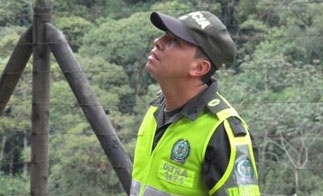An unidentified sniper shot and killed a police commander in the Bajo Cauca region of northern Colombia, a region fought over by the FARC rebels and emerging criminal groups.
According to authorities, Colonel Cristian Florez’s car was hit by three rounds while he was traveling on a road between Taraza and Valdivia in the Antioquia province on July 31, reported El Tiempo. Florez (pictured) was the second-in-command of transport police in the region.
The mayor of Taraza attributed the attack to the 36th Front of the Revolutionary Armed Forces of Colombia (FARC), the branch of the guerrilla group operating in the region. He called for increased security in the area.
Antioquia’s government secretary, Santiago Londoño, said that the FARC could be behind the attack, but also noted that the killing could have been the work of emerging criminal bands (BACRIM) in the area. Londoño announced that the governor would convene a meeting with the heads of security agencies in response to the attack.
InSight Crime Analysis
Florez is the second member of the Antioquia highway patrol to be killed in a little over a year. In June 2011, a concealed explosive device planted by the FARC killed a police major from the highway patrol when he went to a site where the guerrillas had burned three cars.
The dense coca crops and transport connections to both the Pacific and Caribbean coasts in Bajo Cauca make it a hub of activity for both the BACRIM and the FARC. It has never been under the sole control of any of these groups, and so has become a battleground for rival criminal organizations.
Illicit activities in the area run from drug trafficking to unlicensed gold mining operations, many of which are run by the FARC’s 36th Front. Neo-paramilitary criminal organizations have also made inroads in this enterprise in Bajo Cauca.
Taraza in particular is a known operating center for BACRIM groups like the Urabeños, which assembles teams of trained, armed men to buy and protect coca base.

